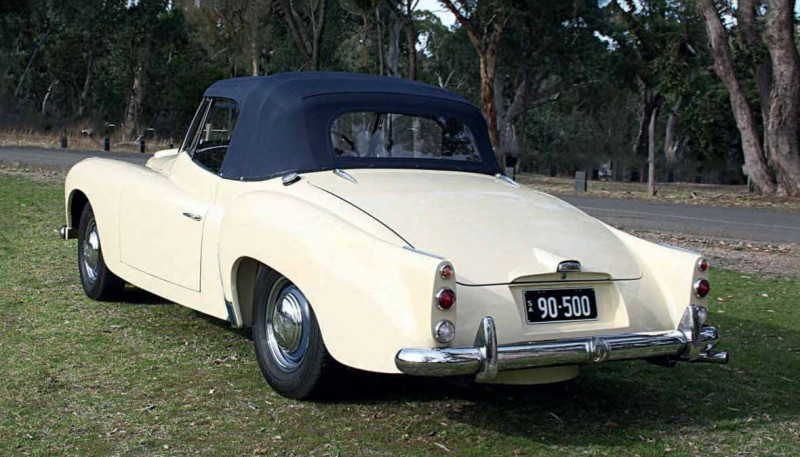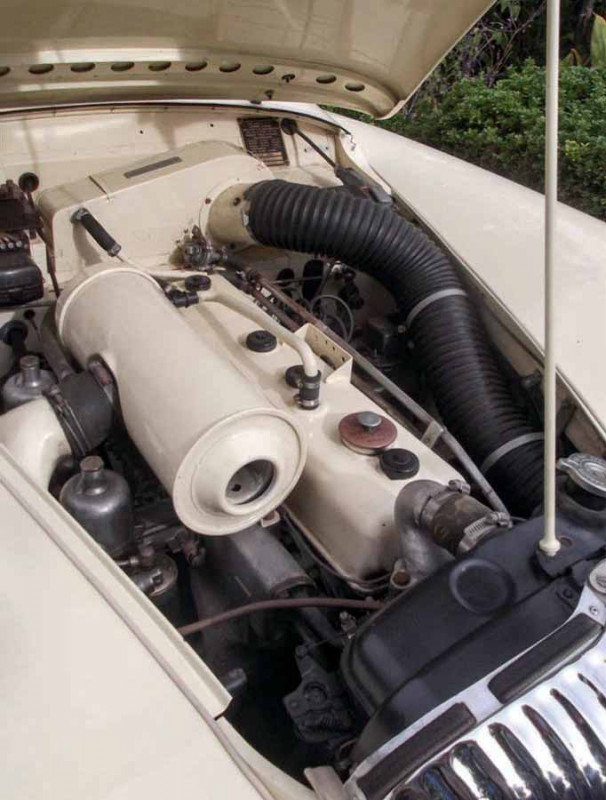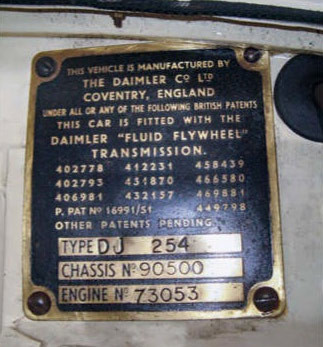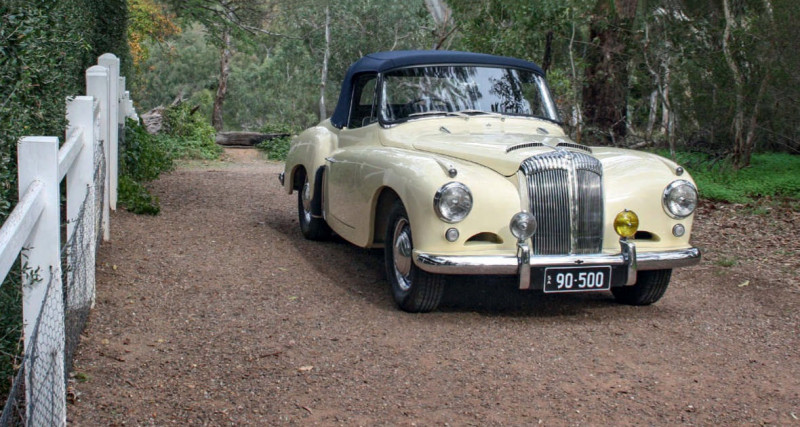1955 Daimler Conquest Roadster
The stylish good looks, sweeping lines, low slung suspension and the fact that it was designed and built in England suggests only one thing – this is a Jaguar sports car. But it isn’t – does that leave you guessing? Words: Richard Holdsworth. Photography: Richard Holdsworth, Peter Holland.
DAIMLER DROPHEAD Prior to Jaguar’s acquisition, Daimler was a competitor, we look at an XK rival
“It has become a family heirloom. The car was registered in my parents’ name until I offered to buy it in the early 1990’s.”
CELEBRATING 125 YEARS OF DAIMLER JAGUAR’S ‘LOST’ MARQUE EXAMINED
LIVES THE HIGH LIFE DOWN UNDER
Peter Holland’s Daimler ‘New Drophead’ Coupe graces the streets of Adelaide the most English of Australian cities, and wherever we go, the car turns heads. One observer thought it must owe its heritage to an Italian design house. Another would risk his wage on the fact that it would be a forerunner of the XK series.

But Peter and his wife Ros are proud of the fact that this is a Daimler and not just because of the car’s good looks. Their car was the very first production New Drophead to leave the factory and has been in Peter’s family, restored and cherished, over the last 56 years of the car’s life and this adds even more flavour to the story. Icing on the cake can be seen when Peter smiles and points to the registration number, 90 500. “That’s the chassis number, Richard.”
Peter Holland has done his research on his unique Daimler and I have to admit that while I appreciated Daimler made fine cars starting just before the turn of the century in 1900, I didn’t fully appreciate just how the Company’s cars enjoyed Royal patronage. And I did not know that the then Prince of Wales had placed an order for three Daimlers to be delivered direct to Buckingham Palace. It seems this patronage lasted until the 1950’s.
Daimler enjoyed successes making high quality cars mainly directed at business owners and those with a little extra spending money. Daimler was amalgamated with Birmingham Small Arms Company (BSA) in 1910 and success followed allowing them to take over the Lanchester Car Company in 1931. Lanchester had styling of their own and it influenced Daimler to a degree. One of the results was the Daimler 15, aimed at the more popular slice of the market.

The war came and, of course, car manufacturers were in the front-line making armaments with cars being the last thing on their minds. But in 1953, Daimler was back and launched a new range, the Conquest range, intended to take up where they left off before hostilities began. The name came from the Norman Conquest of Britain in 1066. Someone in Daimler with a sense of humour also set the price tag, £1066 for the Conquest saloon! And there was a Drophead Coupe for the sportier customers who were prepared to pay just a little more. Both cars were powered by a newly designed 6-cylinder ohv engine of 2433cc. It had a cast iron block and cylinder head and continued with the fluid flywheel and pre-selector gearbox something of a trademark for Daimler cars. The engine developed 75bhp.
“It has become a family heirloom. The car was registered in my parents’ name until I offered to buy it in the early 1990’s.”
Daimler was eyeing the success of the Jaguar XK series and spurred on by this, introduced a roadster version of the Conquest – strictly a 2-seater — again influenced by Lanchester designs. It was powered by a modified version of the engine with aluminium cylinder head and developed 100bhp. It stole the attention of the audience at the 1953 Earls Court Motor Show. The Conquest Century was also launched at the show – the wag in Daimler had been at it again, the name “Century” being a reference to the 100 horse power developed by the engine!

In 1955 the Drophead Coupe 2/3 seater was displayed on the Carbodies stand at the Earls Court Motor Show. This was later described in the Daimler literature as the New Drophead Coupe.
And it could be that this is the car that Peter Holland owns, it being the first full production car to roll out of the factory gates, chassis number – as already stated, 90 500 – engine number 73053 and body DHC001. And it is this car that is attracting such admiring glances from passers-by in the equally attractive city of Adelaide. And I am delighted to be here and in the car’s company along with Peter and Ros and my Aussie wife, Heather, catching it all on camera at our hotel, the Adelaide Inn, O’Connell Street, and the beautiful Belair National Park and Old Government House in the Adelaide Hills.
THE STORY BEHIND THE STORY
Like many youngsters, Peter Holland became interested in cars, and sports cars in particular. Peter was luckier than most and by the mid 1960’s and with the help of his parents, he tells me that the backyard became “littered with cars of choice, a Jaguar Mk5 and a couple of Mk4s plus a Daimler Special Sports…” Enthusiasm was rife in the family and by now his younger brother joined in especially when, in the following year, an XK120 joined the ranks. Not surprisingly, and years later when the South Australian Jaguar Driver’s Club was mooted, Peter was just about the first through the door and became a driving force, holding just about every role within the Club, President, Vice President, Secretary and currently Peter is the Club Patron.

The Club was founded in 1973. Years before that date, the Daimler Drophead came into the Holland family’s ownership. Peter relates how, on a bright Saturday morning in October, 1965, he opened the pages of the State’s premier morning newspaper, The Adelaide Advertiser, and saw the following advert: Private sale exclusive 1955-1956 Daimler Conquest Roadster…
Peter says that he considers this a rather odd description of the car and that may have contributed the motoring fraternity’s apparent lack of interest. But the family’s inquisitiveness got the better of them and they drove over to see the car, father doing the driving. Peter relates how he stayed in the car while the rest of the family went to inspect the Daimler with his father’s words ringing in their ears, “There will be no more bloody old motor cars in my backyard…” But the car looked different, unusual and rather appealing in its cream bodywork and striking red hood and his Dad took an interest and to their amazement walked up to the seller and declared, “We will have this one…”
“The owner was a John Chalmers who had driven the car from Sydney with the intention of continuing to Perth in Western Australia, a total distance of 2700 miles and across the forbidding Nullabor Plain. But due to circumstances, which were not explained at the time, he decided to sell it in Adelaide and go by train to Perth. It was registered with New South Wales number BBZ245, which according to the late Robert Penn-Bradley, a Daimler and Armstrong Siddeley expert, was correct for the period and suggested it may have resided in the Coffs Harbor area of NSW.”
It seems that the Drophead soon became the favourite car with the Hollands and it was first choice for his father when he did his rounds as the local GP. There were other Daimlers in the family – they already owned the Daimler Special Sports and Peter’s brother-in-law owned two 1948 DB18 saloons. But to his father, the Drophead was the best and became ‘King Daimler’.
“This has been retained both as a nickname and a memory of my father who cared so much for this particular car. It has become a family heirloom. The car was registered in my parents’ name until I offered to buy it in the early 1990’s.”

Peter remembers John Chalmers telling how he had bought it from his uncle who had, in turn, bought it off the floor at the Sydney Motor Show. That was August 1956. Peter regrets not asking more especially the history and how the car came to be in Australia. “In 1983 I contacted the Jaguar Publicity Department in the UK as they owned Daimler by that time.
They were good enough to provide a summary sheet which confirmed its colour scheme of ivory body, blue leather and red hood – all of which corresponded with our car. And it is interesting to note that this colour scheme is that shown in the Daimler sales brochures pictures of the time describing the New Drophead Coupe.
“The summary sheet noted that the car was despatched from the Coventry works on 25 February, 1956, and the first guarantee holder was given as K.M. Tozer. It also said that the car was on exhibition at the 1956 Melbourne Show”. Peter says that there is no doubt that K.M.Tozer would have been Tozer, Kemsley and Millbourn, the London based import/export agents for Jaguar and Daimler at that time.
“I have never been able to verify that the car was actually displayed at the Melbourne Show which was held at Easter, April 1956, although there was probably just enough time to reach Australia and take up prime position on the stand. Looking further, I found the records held by the Daimler Lanchester Club Victoria, indicating that Jouberts British Motors, the Victorian Distributor, sold the car to the New South Wales Daimler distributor, Hercules Motors. That date was 8 June, 1956.”
Peter’s further research backs this up. “The motoring supplement in the Sydney Morning Herald of Friday 17 August 1956, has a description and picture of a Daimler Drophead Coupe in the Sydney show. It matches my car and does seem to support the fact that John Chalmers’ uncle did make the purchase at the show as he claimed.” The Sherlock Holmes in Peter Holland now asks, “Was my car the centre of attention on the Daimler stand at the London Earls Court Motor Show of October 1955 before being shipped to Australia? “Carbodies Ltd, who made the bodies for the DJ254 series, describe a Drophead which matches all features of the New Drophead Coupe.
Unfortunately, without actual chassis or body numbers to identify the vehicle on display, this is mere speculation on my part. However, it does suggest that this might have been a prototype on the stand. It is also worth noting that in the Owner’s Handbook of the day plus the Workshop Manual, the chassis number 90500 is specifically mentioned in relation to raising and lowering the hood and other mechanical changes. Peter adds that anyone reading this article who might have any further insight into this aspect of the car’s life – he would be delighted to hear from them. (Peter’s email is: pholland@senet.com.au).
NOW FOR RESTORATION
The Holland family used the car extensively over the ensuing years, but Peter says that there was no doubt it had been given a hard life. “There were body rattles and dropped door hinges testifying to it being driven on country roads with poor surfaces and corrugations (a feature of Australian Outback dirt roads) and there were considerable mud deposits within the wheel arches adding to this theory. The registration plate was also of a country area in New South Wales. The car was nine years old and had covered approximately 63,000 very hard miles. Although it drove well and gave great enjoyment, but by the mid-1970’s, due to dropped door hinges and general body deterioration, Dad decided restoration was the order of the day…”
But tripping the word ‘restoration’ off the tongue is one thing, finding good people to do the work properly and professionally is another. The Daimler was dismantled but promises from two bodyshops were not fulfilled and it was not until 1980 that Peter was confident he had found the right people. “Here was my second mistake (the first not asking John Chalmers more of the history of the car) as I decided to paint the car a dark blue which turned out to look more like purple… Total disillusionment followed.”
Peter retired and among many other activities, booked a trip to the UK and while there made contact with Jaguar Daimler Heritage Trust but this yielded nothing more than already discovered. “Back in Adelaide, I decided it was time for a proper restoration, this starting in December 2005 and finishing in time for the Daimler’s first official run in the Adelaide All British Day held on 13 February 2011.”
Six years is a long time but Peter was determined to get it right this time. I’ll let him explain. “On reflection I felt it was inappropriate to completely change the car’s colour having learned of its early history. It was decided to return the car to its original colour scheme, or almost at least, retaining the ivory body and blue interior.” But rather than retaining red hood and wheels he preferred to keep these in blue thus matching the car’s interior. He felt this was a small but hopefully an acceptable departure from originality.

“We completely dismantled the body including removing the outer aluminium skin from the inner body shell, which was braced and then lifted from the chassis. At this time the probable reason for John Chalmers not proceeding to Perth was discovered as there were signs of accident damage to the left-hand front guard and I do recall him saying a truck had rolled back on the car as it used one of the River Murray ferry crossings. “All rusted sections of the body (which were surprisingly quite extensive) were cut out and replaced with new metal.
I was fortunate to be able to work with Dave Pullman who is an excellent panel beater and metal worker based in Adelaide and Dave brought the body back to life. I did all the dirty work and first fit while Dave did the fine detail repairs. The body was finally reunited with the chassis and taken to Edwardstown Motor Bodies where, under the guidance of Mel Paterson a master spray painter, the Daimler at last began to return to its former glory.”
I am asking, “This is the body taken care of, but what about the interior Peter?” And I am being told of another Adelaide perfectionist when it comes to car restoration. “Allan Smith of Allan Smith Motor Trimming is well known for many E-type Jaguar fit-outs, and he was entrusted with this work. (I wonder whether he was the man who made a new tonneau cover for my Porsche 356 when I lived in Adelaide – I can certainly vouch for this work being excellent).
New leather and carpets were installed and, of course, a new hood. Again, being hands on, I remade or repaired all the base timber frames and panels prior to Allan performing the difficult bits. “While all the bodywork, painting and trimming was taking place, I undertook the mechanical rebuild of the car. This included refurbishing the engine, the preselector gearbox (which was about to self-destruct), the fluid flywheel (no leaks, I am proud to say), brakes and front and rear suspension. Some of the mechanical repairs are almost worthy of a separate story.”
DRIVING “KING DAIMLER”
Peter tells me that the Daimler drives like any quality car of that era. “With no power assisted steering, it is heavy to park and manoeuvre at slow speed but once out on the road it is very pleasant to drive.” Peter says that he has found the handling of the Daimler Drophead is solid and predictable and he concludes this is due, in no small measure, to the massive laminated torsion bars which are a feature of the independent front suspension. “It is interesting that the rear coupling adaptors attaching the torsion bars to the chassis can be installed two ways, effectively shortening the torsion bars by a small amount. The workshop manual notes that this function allowed for driving conditions on rough roads. Perhaps this could be likened today to sporting or touring conditions?
“In my opinion the only downside was the use of a 4.11 diff ratio, which means first gear is very low and only suitable for climbing cliffs! The 3.73 ratio used in the Roadster would have been more desirable. Indeed, the workshop manual states the 4.11 ratio was introduced at chassis 90500.”
THANKS TO
Now Peter Holland wants to acknowledge those who have helped him with the beautiful Daimler. And top of his list is his wife, Ros, (“50 years since we met and started sharing cars and radios, my other passion”), his younger brother, Christopher, members of various enthusiast’s clubs (especially the Jaguar Drivers’ Club of South Australia) and the tradespeople who have worked on the car. “At times I have been privileged to share with them as a hands-on owner… morning coffee at “smoko” time, a very rare privilege in today’s commercialised world.”
NEXT PROJECT
Peter Holland’s next project is the full body-off restoration of his XK120 Roadster, a car which was delivered new to a Jaguar enthusiast in Adelaide in 1950. The XK is well on the way to coming back together; body and chassis have been reunited, with great attention being paid to ensure total authenticity — but that is a story reserved for another day and only when the work is completed.
“I decided to paint the car a dark blue which turned out to look more like purple… Total disillusionment followed.”
A start is made on removing the blue paint. The Daimler stripped down to bare essentials.
The first restoration and re-painting in blue didn’t appeal.
With the chassis sand-blasted and painted, front suspension and wheels are re-fitted as is the back axle.
Rust removed and the body taken back to bare metal before the first undercoat is applied.
A start is made on returning the body to the chassis frame.
Painstaking attention to detail and perfection is shown in the preparation of the body.
The next stage in the lengthy restoration starts to show a marvelous Daimler drop-head re-appear once again. It took six years.


